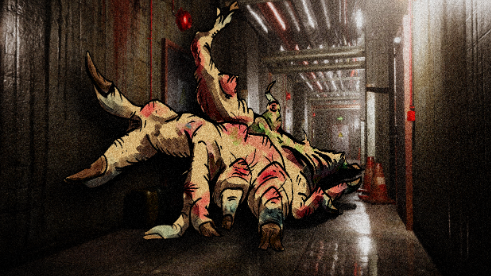Personal Reflection - An Artists Statement
As a filmmaker, digital and traditional illustrator, my creative journey thrives on the balance between mediums. In film, I navigate the precision of digital recording, where endless possibilities in post-production fuel my imagination, and the tactile richness of analog film, which captures raw, emotional depth. This duality mirrors my work as an illustrator, where digital tools offer flexibility while traditional methods evoke a personal connection with each stroke. As a determined artist and recovering workaholic, I find joy in both the process and practice of storytelling through visual art.
COVENANT
An Occult Thriller and Mystery
When I wrote Covenant, I tapped into my love for the classic private detective story. There's something about a man on the fringes, operating outside the usual systems, that has always intrigued me. In Covenant, my protagonist is that kind of figure, a detective driven not just by the law, but by his need to uncover truths that others are too afraid or too unwilling to face.
I’ve always admired the detective who keeps digging when no one else will, who doesn’t settle for easy answers. It’s the same quality I strive to bring to my work. Whether I’m writing or creating visually, I’m always searching for the next layer, the deeper meaning that lies beneath the surface. Like my protagonist, I want to unravel the mysteries that others pass by.
Covenant allowed me to bring that passion to life in a story. It’s not just about solving the case, but about exploring the unknown, facing things that challenge our understanding of the world. In many ways, it mirrors my approach to art, where I’m always searching for the story behind the image, the truth behind the emotion. Just like my detective, I’ll keep looking for those answers, no matter how deep I have to dig.
MADE IN OUR IMAGE
Horror Reflects our Fears and our Aspirations
When I created Made in our Image, I wanted to explore horror from a different perspective. To me, horror isn't just about what scares us, it’s about our desires and ambitions, the things we push for without questioning if we should. We often get caught up in what we can do, in our ability to control and shape the world around us, without fully understanding the consequences.
This piece reflects how our creations, whether they’re advancements in technology, attempts to master nature, or even just our efforts to control everyday life, are reflections of ourselves. We want to play God, to mold the world in our image, but sometimes those attempts backfire in ways we can’t predict. That’s where horror comes in, showing us that there are limits to what we can control and that some things are beyond our understanding.
In Made in our Image, I wanted to show that the horrors we create are often a reflection of our own ambitions. We push too far, trying to master things that maybe we shouldn’t, and horror becomes the result of our own drive. It’s a reminder that some things need to be left alone, that not every boundary is meant to be crossed.
Patron Saint of Looking - Kim Jung Gi
Kim Jung Gi is, in my eyes, the Patron Saint of Looking. His art, prolific in volume and depth, was a testament to the importance of observation, both in art and in life. As an artist who consistently pushed the boundaries of what is possible with a pen and an empty page, Kim Jung Gi demonstrated that the true source of inspiration comes from the world around us, and that an artist’s greatest muse is not confined to the imagination but is all around, waiting to be captured. His work ethic, rooted in a seemingly insatiable need to observe, record, and create, speaks to the power of taking in the world’s details and translating them into a visual language.
For Kim, the act of looking was not passive but rather an active engagement with the world. His drawings, often done without preliminary sketches, showed a deep understanding of form, structure, and perspective. He possessed an almost encyclopedic knowledge of anatomy, architecture, and nature, and this allowed him to compose intricate, fully realized images directly onto paper with an uncanny level of accuracy and detail. His process revealed a mind that was constantly cataloging information, each glance a potential piece of art in the making.
What is most profound about Kim Jung Gi's legacy is the way in which he embodied the lifestyle of the artist, not just in the act of creation but in the way he viewed the world. His humility, despite his fame and the reverence he received from fellow artists, speaks volumes about the authenticity of his passion. For him, drawing was not just a job or a performance; it was as natural as breathing. The immense volume of work he produced over his career, whether personal sketches, commissions, or collaborative projects, demonstrates not only his technical prowess but also the ease with which he seemed to live and breathe art.
Kim's humility is an essential part of why I view him as the Patron Saint of Looking. Despite the global recognition he gained, his attitude remained grounded. His humility was not a rejection of praise, but rather a reflection of how deeply ingrained the practice of looking, observing, and creating was to him. His sense of purpose and passion seemed to transcend the external validation of fame, as though the act of seeing and drawing was itself enough to sustain him. In this way, Kim taught a crucial lesson to artists everywhere, that creating art should be a way of life, a practice inseparable from the way we experience the world.
He reminds us, as artists, that our muse is always present. From the streets we walk to the people we meet, to the mundane details that often go unnoticed, there is always something worth recording, worth capturing. Kim’s life and work embody the artist’s eternal task of observation. He was constantly “looking,” not with passive eyes but with the eyes of someone who understood that each observation was an opportunity for creation.
In the end, what makes Kim Jung Gi’s work so powerful is not just its technical skill but the underlying philosophy it represents. His drawings were a reflection of his deep connection to the world around him, a connection that transcended the page. He has left behind more than just a body of work, he has left behind a legacy of seeing, one that urges artists to never stop looking, never stop observing, and never stop creating from what they see.
For these reasons, Kim Jung Gi’s legacy is not just about the remarkable illustrations he left behind, but about how his life and work emphasize the importance of seeing the world with the artist's eyes. His prolific career, driven by a relentless curiosity and an untiring desire to create, is a reminder that the world will always have more to offer us if we are willing to truly look.




